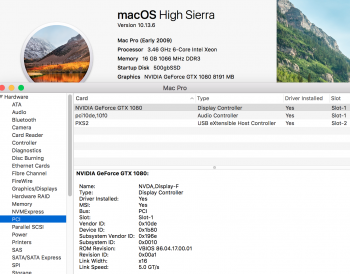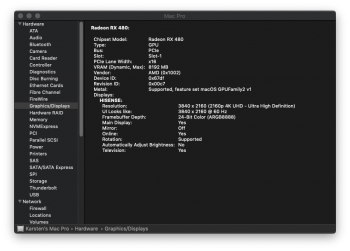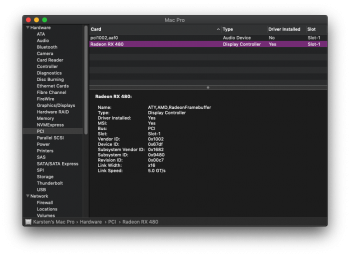Got a tip for us?
Let us know
Become a MacRumors Supporter for $50/year with no ads, ability to filter front page stories, and private forums.
MP 1,1-5,1 MacPro5,1: BootROM thread | 144.0.0.0.0
- Thread starter tsialex
- WikiPost WikiPost
- Start date
- Sort by reaction score
You are using an out of date browser. It may not display this or other websites correctly.
You should upgrade or use an alternative browser.
You should upgrade or use an alternative browser.
- Status
- The first post of this thread is a WikiPost and can be edited by anyone with the appropiate permissions. Your edits will be public.
tsialex
I really must commend you on the sheer amount of research & experimentation regarding NVMe booting and the mysteries of the cMP bootrom.
Since the " Gilles NVMe Boot Breakthrough" the power of our cMP's has been greatly enhanced thanks to your and many other's determined efforts. I'm sure that many others in the Mac Pro thread echo my sentiments.
Many thanks
I really must commend you on the sheer amount of research & experimentation regarding NVMe booting and the mysteries of the cMP bootrom.
Since the " Gilles NVMe Boot Breakthrough" the power of our cMP's has been greatly enhanced thanks to your and many other's determined efforts. I'm sure that many others in the Mac Pro thread echo my sentiments.
Many thanks
I also want to know if there is anything changed. There are four cases. We need at least two cards to done all the checks.
1) flashed card, no loading
2) flashed card, with loading (e.g. CUDA-Z), THEN open system info PCIe Page.
3) unflashed card, no loading
4) unflashed card, with loading (e.g. CUDA-Z), THEN open system info PCIe Page.
So far, we know 1 and 3 will shows 2.5GT/s, nothing changed after firmware update.
But 2 and 4 still need tests to confirm.
[doublepost=1534483072][/doublepost]
But stay at 80C with low fan speed seems not quite right. Do you know the fan profile, target temperature etc for the Vega FE?
[doublepost=1534488472][/doublepost]
You really thought opening Cuda-Z would make a difference?
Well, I tried looking at PCI info with both Cuda-Z and OceanWave open (not simultaneously). NO DIFFERENCE! 2.5GT/s. So cross 2) off your list.
Lou
If anyone cares, I just got a GTX 1080 (non-Ti) founder's edition last night and it shows 5GT. I am running MacOS photos, iTunes, and a few other background apps - nothing actively displaying 3D though. The only things I've done are the 4,1->5,1 flash and HDMIaudio.kext, no NVMe or MVC thingamabobs:


[edit]
did a full shutdown/cold boot, no difference. still 5GT/s.
Could you please post a screenshot of Mojave System Profiler>Hardware>Graphics/Displays with your RX 480?i just did the mojave update from HS with a 480 and didn't have a EFI upgrade screen visible but waited patiently and it eventually booted up. all is well in the desert
Like this:
Last edited:
I was studying the trashcan dump, and found that it has ME active and rather old:

I know that MP51 don't have Intel Management, but just for kicks, I've checked MP51.fd too:

I know that MP51 don't have Intel Management, but just for kicks, I've checked MP51.fd too:
Hi!
One note that I discovered: You need to disabel SIP once more, when you upgrade to 138'. This to be able to run Bootchamp. I booted back in recovery-mode and was promted to choose language.
And thanks to tsialex for helping me to upgrade.
So now I´m running 10.13.6 on Firmware 138' and NVMe M.2.
/Per
One note that I discovered: You need to disabel SIP once more, when you upgrade to 138'. This to be able to run Bootchamp. I booted back in recovery-mode and was promted to choose language.
And thanks to tsialex for helping me to upgrade.
So now I´m running 10.13.6 on Firmware 138' and NVMe M.2.
/Per
One note that I discovered: You need to disabel SIP once more, when you upgrade to 138'.
Nice that it's working!
Just to correct, you needed to disabled SIP again because I wiped the NVRAM area of your new BootROM and the default state for SIP is enabled. Not because 138.0.0.0.0.
Every time you flash a cleaned/reconstructed BootROM, you will need to disable SIP again. I can make SIP disabled by default in reconstructed BootROMs, but I'm not gonna do it for now.
I think that's the best way to reconstruct a BootROM is to do it as the manufactured did originally. Imagine that you replaced your logic board with a brand new one, so I do with the same settings as a new one.Well, thanks. You are like a neurosurgeon doing stuff (under the "hood") that we deadly do not undersand.
/Per
In the future, maybe we can automate somethings, like SIP disable, Nvidia drivers and more.
I think that's the best way to reconstruct a BootROM is to do it as the manufactured did originally. Imagine that you replaced your logic board with a brand new one, so I do with the same settings as a new one.
In the future, maybe we can automate somethings, like SIP disable, Nvidia drivers and more.
This is a good point, we can actually make Nvidia web driver Enabled by default even after a PRAM reset.
I can't say this for sure yet (make settings permanently on the public part of NVRAM), but it's something that I'm gonna test later.This is a good point, we can actually make Nvidia web driver Enabled by default even after a PRAM reset.
I know that Apple has a diagnostic tool that can do this. My brother has a rMBP that Apple forgot to remove the diag data from NVRAM, and zap-PRAM don't clear the settings. That got me thinking…
I didn't dump this rMBP yet, the next my time my brother come visit us I'll dump it.
Last edited:
I've updated to the last firmware 138.0.0.0.0 from high Sierra with a GTX 980ti and all good  was easy.
was easy.
Could you please post a screenshot of Mojave System Profiler>Hardware>Graphics/Displays with your GTX 480?
Sure thing--
Sadly the card still has a sleep/wake issue with the monitor so I'm going to attempt the CFG_FB_LIMIT kext mod as described here https://www.theitsage.com/fix-rx-580-sleep-issue-10-13-2/ (the 2nd method) hopefully the Kext Utility app will work on Mojave to repair permissions. I used the one from Tonymac on HS and it borked the system and had to reinstall the OS bleh.
edit- forgot to add this is a XFX 480 Black edition (reference OC with backplate)
edit2- Kext Utility works in mojave
Attachments
Last edited:
Today I checked my 089 ROMdump for the important identifiers if any information is missing but I struggle to find the LBSN and the BD. Hexfiend does not give any search results on 'lbsn' or a build date. Are they encrypted somewhere? Can anybody tell me where these numbers are located?
Yeah, if someone is willing to make a simple DIY on the common things to check for in a firmware to see if it’s corrupted that would be rad.
I did a preliminary doc detailing things, checked 18 different unique MP51s so far, but I'm still finding things wrong.Yeah, if someone is willing to make a simple DIY on the common things to check for in a firmware to see if it’s corrupted that would be rad.
So, please wait until I document the things I found and make a guide on how to reconstruct a BootROM based on Apple LOCKED.fd files.
If your Mac Pro behaves strangely on boot, you can't login with iCloud/FaceTime/iMessage, please dump/compress/PM me it.
[doublepost=1535241950][/doublepost]
Anybody have an answer - Post #578 and #579?
Lou
If I'm understanding right, it's a MVC flashed cards thing. Maybe it's best to directly ask Rominator for more info.
Last edited:
Sorry to be dense, but just so I have this straight, there's no workaround or utility or something to apply only the v138.0.0.0.0 firmware update, right? From what I can tell here, there's not:
Working on a Snow Leopard machine w/ a pair of 512GB SSUBX SSD blades installed, and would love to move from slots 3&4 to 2&3 to get them off of the same PCIe channel and both operating at 5GT/s. But it only has/needs the GT120. This is a client machine, and the only Metal card I have is an RX 580 in my own tower elsewhere. Would rather avoid having to start playing musical GPUs...
Thx,
Fred
The macOS Mojave installer app checks the GPU before letting you upgrade the BootROM, you can manually upgrade but since we have at least 5 or more suspected cases of SPI-flash corruption here, two confirmed, it's best that you don't do it yourself.
I recommend that you upgrade your GPU first.
Working on a Snow Leopard machine w/ a pair of 512GB SSUBX SSD blades installed, and would love to move from slots 3&4 to 2&3 to get them off of the same PCIe channel and both operating at 5GT/s. But it only has/needs the GT120. This is a client machine, and the only Metal card I have is an RX 580 in my own tower elsewhere. Would rather avoid having to start playing musical GPUs...
Thx,
Fred
Sorry to be dense, but just so I have this straight, there's no workaround or utility or something to apply only the v138.0.0.0.0 firmware update, right? From what I can tell here, there's not:
If the Mac Pro is running 10.13.6, pre-requirement, download Mojave PB7 and open it to upgrade your Mac Pro firmware. After the upgrade, when it restarts on High Sierra, just close the Mojave installer.
You will need to change the GPU, GT120 is rejected by Mojave installer.
If your Mac Pro is on 10.13.6, pre-requirement, download Mojave PB7 and open it to upgrade your Mac Pro firmware. After the upgrade, when your Mac Pro restarts in High Sierra, just close the Mojave installer.
Ugh. Sorry. I didn't put all of the details in my question. Should read: there's no workaround or utility or something to apply only the v138.0.0.0.0 firmware update without a Metal-supported card, right?
Thanks for the hyper-fast response, BTW!
Ugh. Sorry. I didn't put all of the details in my question. Should read: there's no workaround or utility or something to apply only the v138.0.0.0.0 firmware update without a Metal-supported card, right?
Thanks for the hyper-fast response, BTW!
You can dump the current BootROM with ROMDump/ROMTool and I can reconstruct 138.0.0.0.0 with the Mac Pro identifiers. Then you flash the new one with ROMTool.
You can upgrade manually with efiflasher + bless, but it's a lot riskier and I'm not gonna explain how to do it.
You can dump the ROM with ROMDump and I can reconstruct 138.0.0.0.0 with the Mac Pro identifiers.
Wow, thank you. I must admit, I'm not familiar w/ the tool. Can you point me to a quick reference or how-to? Will I just "reinsert" the reconstructed ROM w/ the same tool after you've worked your magic?
Also, from what I've seen here lately, your work here in helping folks out is amazing...if it's more than a few minutes' effort on your part, just tell me, and I'll suck it up and do some card-swapping!
I'll PM you with how to do it, wait a minute or two.Wow, thank you. I must admit, I'm not familiar w/ the tool. Can you point me to a quick reference or how-to? Will I just "reinsert" the reconstructed ROM w/ the same tool after you've worked your magic?
Also, from what I've seen here lately, your work here in helping folks out is amazing...if it's more than a few minutes' effort on your part, just tell me, and I'll suck it up and do some card-swapping!
Register on MacRumors! This sidebar will go away, and you'll see fewer ads.




